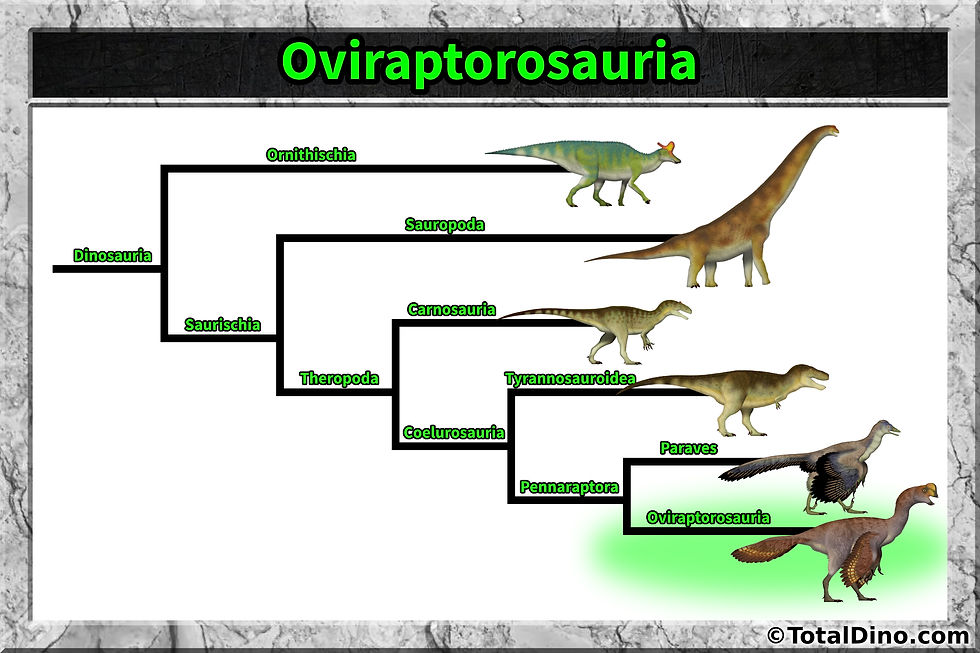Eoneophron
- Total Dino
- Jan 5
- 3 min read
Updated: Sep 28
MEANING: Pharaoh's dawn chicken
PERIOD: Late Cretaceous
CONTINENT: North America
Caenagnathids like Eoneophron can be differentiated from other oviraptorosaurs by their jaws, which were generally long and shallow, suggesting a less powerful bite. Caenagnathids were also more lightly built, with slender arms and long gracile legs, though they weren't especially cursorial. Eoneophron's body mass is estimated at about 78 kg.

Abstract from paper: Caenagnathidae is a clade of derived, Late Cretaceous oviraptorosaurian theropods from Asia and North America. Because their remains are rare and often fragmentary, caenagnathid diversity is poorly understood. Anzu wyliei is the only caenagnathid species currently described from the late Maastrichtian Hell Creek Formation of the USA and is also among the largest and most completely preserved North American caenagnathids. Smaller, less complete caenagnathid material has long been known from the Hell Creek Formation, but it is unclear whether these are juvenile representatives of Anzu or if they represent distinct, unnamed taxa. Here, we describe a relatively small caenagnathid hindlimb from the Hell Creek Formation, and conduct osteohistological analysis to assess its maturity. Histological data and morphological differences from Anzu wyliei and other caenagnathids allow us to conclude that this specimen represents a new species of caenagnathid from the Hell Creek Formation, with a smaller adult body size than Anzu. This new taxon is also distinct from other small caenagnathid material previously described from the area, potentially indicating the coexistence of three distinct caenagnathid species in the Hell Creek Formation. These results show that caenagnathid diversity in the Hell Creek ecosystem has been underestimated.
Eoneophron is from the Late Cretaceous. The Cretaceous is the third and final geological period of the Mesozoic Era, with the Late Cretaceous making up roughly the second half of it, lasting from about 100 to 66 million years ago. It was a time of significant evolutionary change, with dinosaurs reaching their greatest diversity before the mass extinction at the end of the Cretaceous.
The Cretaceous was a period with a relatively warm climate, though the Late Cretaceous experienced a global cooling trend, caused by falling levels of carbon dioxide in the atmosphere. The continents were nearing their present positions, but high sea levels flooded low-lying regions, turning Europe into an archipelago, and forming the Western Interior Seaway in North America. These seas were home to a variety of marine reptiles, including mosasaurs and plesiosaurs, while pterosaurs and birds shared the skies.
On land, dinosaurs continued to thrive and diversify during the Late Cretaceous, producing many of the most well-known groups, including tyrannosaurs, hadrosaurs, and pachycephalosaurs. Established Cretaceous dinosaur clades like the ceratopsians, ankylosaurs, and dromaeosaurs continued to flourish. Sauropod species consisted almost exclusively of titanosaurs, which seemed to be confined to the Southern Hemisphere for much of the Late Cretaceous. Flowering plants and grasses diversified and spread, becoming the dominant flora similar to what we see today.
The Cretaceous (along with the Mesozoic) ended with the Cretaceous-Paleogene (K-Pg) extinction event, a large mass extinction in which many groups, including non-avian dinosaurs, pterosaurs, and large marine reptiles, died out. This event, likely triggered by an asteroid impact, is marked by the abrupt K-Pg boundary, a distinct geologic layer separating the Mesozoic and Cenozoic Eras. In its aftermath, mammals and avian dinosaurs rapidly diversified, becoming the dominant land animals of the Cenozoic Era.

Eoneophron is an oviraptorosaur. Oviraptorosauria is a group of feathered theropod dinosaurs that lived during the Cretaceous Period and are known for their unusual, often bird-like anatomy. These dinosaurs were part of the larger clade Pennaraptora, which also includes birds, dromaeosaurs, and troodontids, and they show a mosaic of primitive and advanced traits that highlight their close relationship with birds.
Physically, oviraptorosaurs are characterized by their short, beaked snouts, often lacking teeth or bearing only a few reduced teeth at the front of the jaws. Many had elaborate cranial crests, which may have been used for display or species recognition. Their hands were relatively short but powerful, and their arms were often covered in feathers. Oviraptorosaurs were bipedal and typically had long legs suited for walking or running, with tails often stiffened by elongated vertebrae, possibly for balance or display. Fossils show that their plumage was not limited to basic fuzz but included complex feathering, similar to modern birds.
Oviraptorosaurs ranged in size from small species barely a meter long to much larger animals, including some over three meters in length. Their diet is still debated: some were likely herbivorous or omnivorous, using their strong, toothless beaks to process a variety of plant material, eggs, shellfish, or small animals. The discovery of nesting adults on top of egg clutches - some with embryonic remains inside - has given paleontologists valuable insight into their reproductive behavior, which appears to have been highly bird-like. Altogether, oviraptorosaurs offer a remarkable look at the diversity and evolutionary experimentation occurring within the feathered dinosaurs of the Cretaceous.













